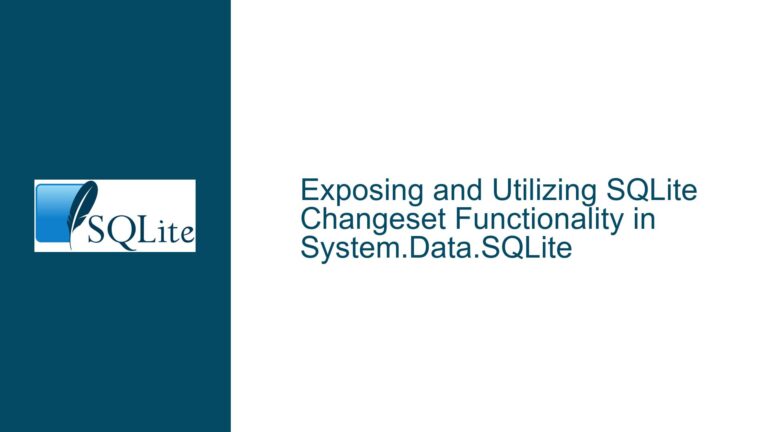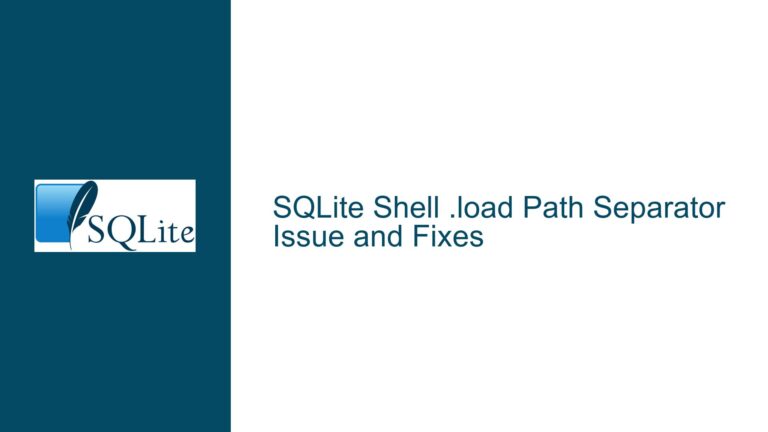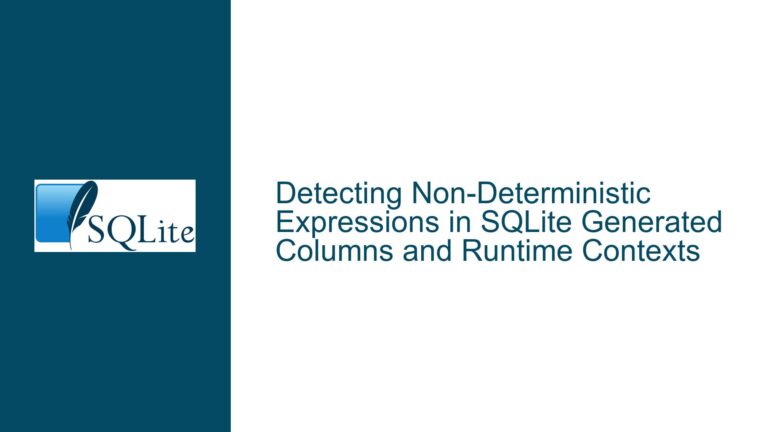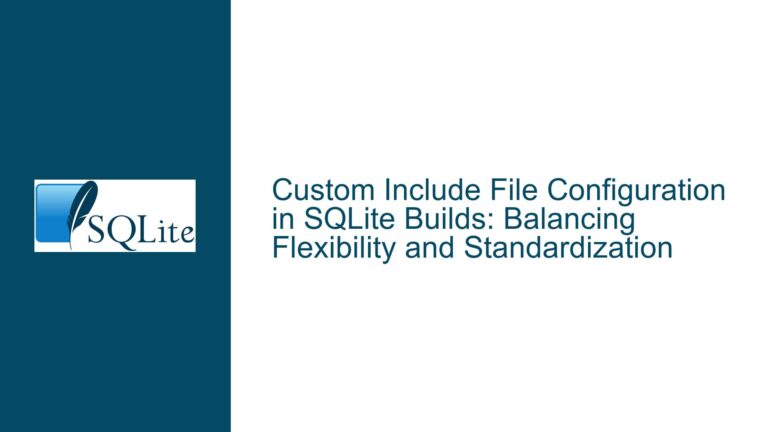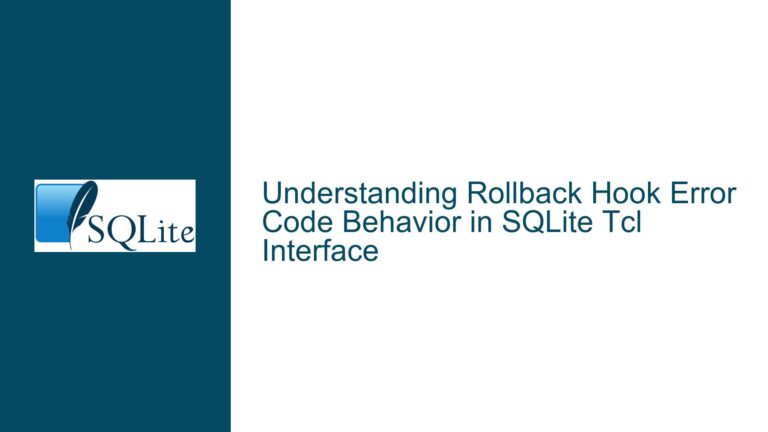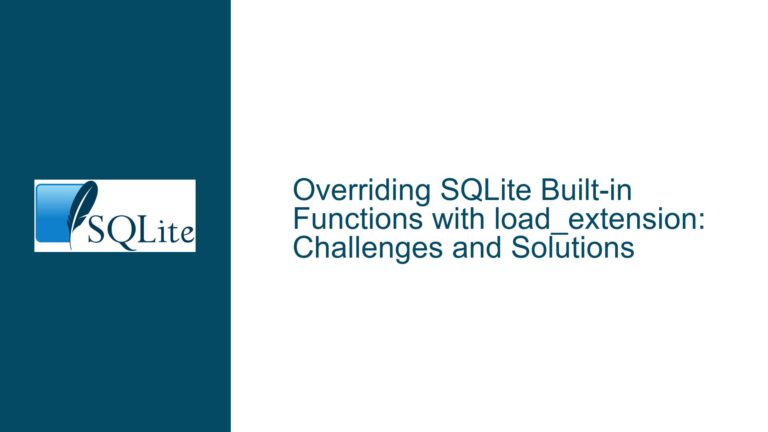Reliability of SQLite Database Timestamps for Build Process Synchronization
Understanding SQLite Database Timestamp Behavior in Idempotent Operations
Issue Overview: Database Timestamp Inconsistencies in Build Systems
The core challenge revolves around whether SQLite reliably updates the database file’s modification timestamp (mtime) when executing idempotent operations (e.g., CREATE TABLE IF NOT EXISTS, INSERT OR IGNORE) that do not logically alter the database. This is critical in build systems (e.g., make) where file timestamps determine whether dependent tasks (e.g., data extraction from source files) must execute. If the database file’s timestamp changes despite no logical changes, the build system might skip necessary steps, leading to stale data. Conversely, if the timestamp does not update when changes occur, the system might redundantly reprocess unchanged data.
Key Contextual Factors:
- Build System Reliance on Timestamps: Build tools like
makeuse file modification times to decide whether to rebuild targets. If a SQLite database’s timestamp does not accurately reflect logical changes, the build process becomes unreliable. - Idempotent Operations: DDL (e.g.,
CREATE TABLE IF NOT EXISTS) and DML (e.g.,INSERT OR REPLACE) statements may not modify the database if their preconditions are already met. The question is whether SQLite writes to the file in these cases, updating its timestamp. - External Influences: Filesystem quirks, journaling modes, and third-party tools (e.g., antivirus software) can alter timestamps independently of SQLite’s operations.
Critical Observations from the Discussion:
- SQLite avoids unnecessary disk I/O, so logically idempotent operations might not write to the file.
- Hot journals (leftover from crashes) force SQLite to perform recovery operations, which modify the database file even during read-only access.
- Filesystems and OSes handle timestamp updates inconsistently (e.g., Windows vs. Unix-like systems).
Root Causes of Timestamp Ambiguity in SQLite Databases
1. SQLite’s Journaling and Write-Ahead Logging (WAL) Mechanisms
SQLite uses journal files to ensure atomic transactions. The behavior of these journals directly impacts timestamp updates:
- Rollback Journal Mode:
- In
DELETEjournaling mode, changes are first written to a separate journal file. The main database file is modified only after the transaction commits. However, if a hot journal exists (indicating an interrupted transaction), the next database access (even read-only) triggers a rollback, modifying the database file and updating its timestamp.
- In
- WAL Mode:
- WAL decouples writes by appending changes to a separate log file. The main database file is modified less frequently, so its timestamp might not reflect recent logical changes. However, checkpoint operations (which merge WAL changes into the main database) will update the timestamp.
2. Filesystem and OS-Specific Timestamp Handling
Filesystems vary in how they update timestamps:
- Last-Modified Time (
mtime):- Some filesystems update
mtimeonly when the file is closed after a write. Others update it on every write operation. - Example: On Windows with NTFS, opening a file in read-write mode without modifying it might still update
mtimedue to metadata changes.
- Some filesystems update
- Antivirus and Backup Software:
- Tools like McAfee may open files with read-write locks for scanning, inadvertently updating
mtimeeven if SQLite made no changes.
- Tools like McAfee may open files with read-write locks for scanning, inadvertently updating
3. Idempotent Operations and Internal Optimizations
SQLite’s internal optimizations can bypass disk writes:
- Schema No-Ops:
CREATE TABLE IF NOT EXISTSchecks the schema without writing to the database if the table exists. However, schema checks may still involve read operations that interact with journal files.
- DML Optimizations:
- Statements like
INSERT OR IGNOREthat do not insert new rows may avoid writing to the database. However, transaction boundaries (e.g.,BEGIN IMMEDIATE) can force writes to journals.
- Statements like
Resolving Timestamp Ambiguity: Strategies for Build Systems
Step 1: Eliminate Reliance on Database Timestamps
Instead of depending on mtime, use deterministic checks to assess whether the database has changed relative to source files:
Solution: Content Hash Comparison
Generate a hash of the database’s content and compare it to a previously stored hash. This bypasses timestamp ambiguity entirely.
# Generate SHA-256 hash of the database
sha256sum mydatabase.db > .current_hash
# Compare with previous hash
if ! cmp -s .current_hash .previous_hash; then
# Trigger build steps
cp .current_hash .previous_hash
fi
Solution: Version Metadata Table
Add a table to track the database’s logical version and update it explicitly during changes:
-- Initialize version table
CREATE TABLE IF NOT EXISTS _version (id INTEGER PRIMARY KEY, version INTEGER);
INSERT OR IGNORE INTO _version (id, version) VALUES (1, 0);
-- Increment version during data updates
UPDATE _version SET version = version + 1 WHERE id = 1;
In your build script, query the version field to determine if updates are needed.
Step 2: Mitigate Hot Journal and Journaling Mode Effects
Fix: Disable Rollback Journals with Caution
Use PRAGMA journal_mode = WAL; to reduce the frequency of main database writes. Note that checkpoints (which update the main database) can still modify mtime.
Fix: Explicitly Remove Hot Journals
After crashes or interrupted transactions, delete leftover journals before accessing the database:
# In build script preamble
rm -f mydatabase.db-journal mydatabase.db-wal
Step 3: Control Timestamps Explicitly
Fix: Manually Set Modification Time
After confirming no logical changes, set the database’s mtime to match the newest source file:
# Get the newest source file timestamp
NEWEST_MTIME=$(find sources/ -type f -printf '%T@\n' | sort -n | tail -1)
# Set database mtime explicitly
touch -d "@$NEWEST_MTIME" mydatabase.db
Fix: Isolate Database Access
Use a dedicated filesystem or container to minimize interference from antivirus or backup tools. For example, mount a RAM disk for temporary databases:
# Create a RAM disk (Unix-like systems)
mkdir -p /mnt/sqlite_ramdisk
mount -t tmpfs -o size=512M tmpfs /mnt/sqlite_ramdisk
Final Recommendations for Build Systems
- Avoid
mtimefor Critical Decisions: Use content hashes or version tables. - Standardize Filesystem Behavior: Test across target platforms (e.g., ext4, NTFS).
- Monitor External Processes: Audit tools that interact with the database file.
By decoupling build logic from filesystem timestamps and leveraging SQLite’s transactional metadata, you ensure reliable incremental builds regardless of underlying storage quirks.

